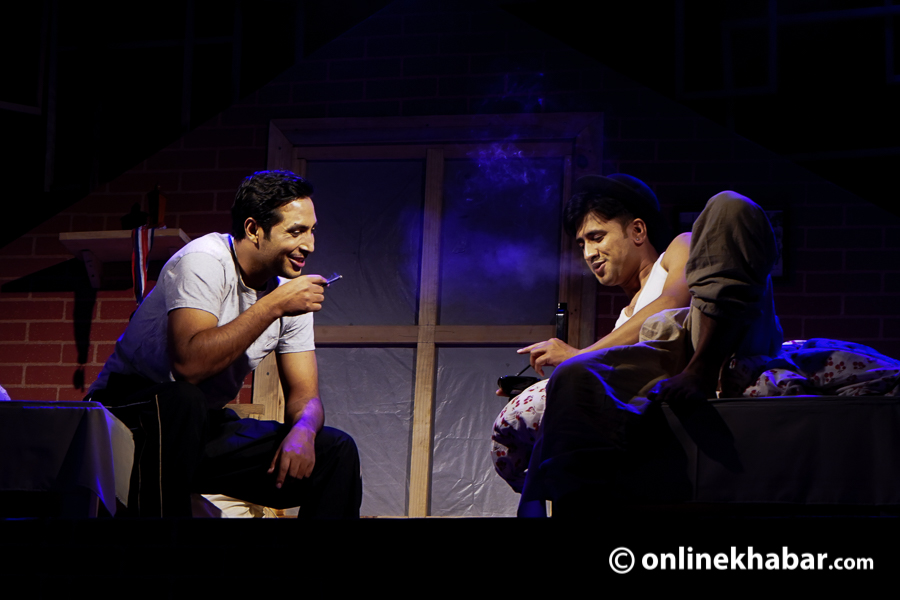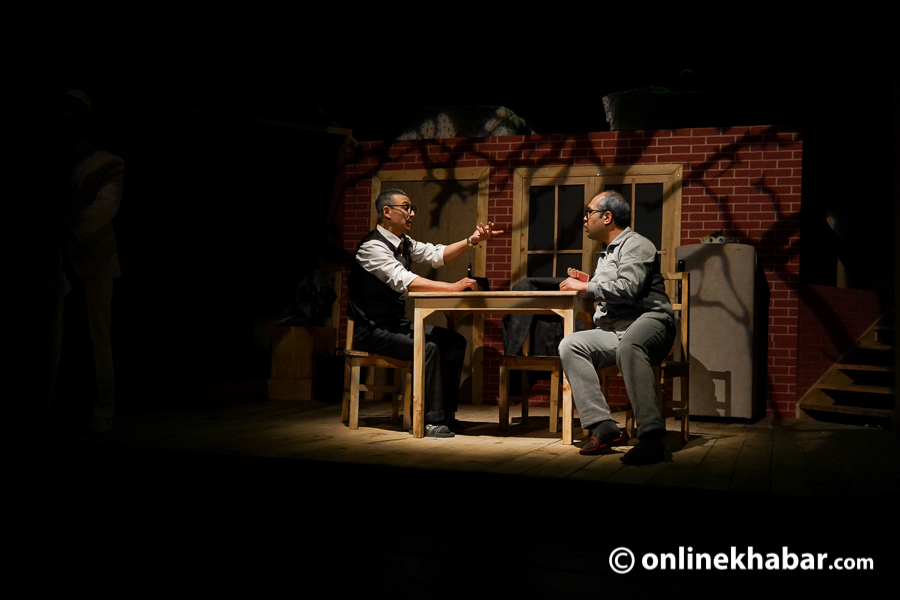
Spring is here in Kathmandu but the past few days have not been springlike. The cloudy sky is discouraging you from leaving indoors, more so when it is the weekend.
I went to the Mandala Theatre in Kathmandu this Saturday afternoon only because I was not home since the early morning. But I wondered why so many people gathered there on the rainy weekend–until I completed the three-hour-long show of Euta Sapanako Awasan, the Nepali adaptation of Arthur Miller’s magnum opus Death of a Salesman.
After all, Biplav Pratik’s translation and Anup Baral‘s direction of the play originally staged in the US in 1949 deserved an enthusiastic footfall.
Promise and potential

Euta Sapanako Awasan revolves around the vicissitudes of Biren Pratap Karki’s life and his middle-class family.
Usually, a middle-class family has to go through many ups and downs concerning jobs, finances and education. While many families can be successful in settling them, many families cannot, leading themselves to a catastrophe. As the title suggests, Euta Sapanako Awasan [literally, the death of a dream] has a catastrophic end.
Although the play was written seven decades back, the “adapters” have worked well to make it relevant still today in the Nepali context. Moreover, someone from a middle-class family who strives and dreams for a job, quality education, healthy family life and overcoming financial loans can easily relate to the play.
Let’s not discuss much of the plot as Death of a Salesman has been reviewed multiple times globally. Let me get focused on the Nepali adaptation.
Despite the tragic story, fans of Nepali theatre can be happy about the performance of Euta Sapanako Awasan at Mandala. It shows a promising future of the Nepali theatre, in particular the future of the Nepali adaptation of Western masterpieces.
For example, let’s consider time transition. Doubtlessly, Death of a Salesman has a confusing plot as it switches between the present and the past. These are not only two different times, but these are two different situations. The past was happy but the present is sad; the past was all about dreams but the present is all about depression. To highlight the differences, the director has chosen different actors to play the same role, in particular two sons of Willy Loman, I mean Biren Pratap Karki, the salesman. This is a prudent choice.
Perfect characterisation

In addition to its tragic plot, Euta Sapanako Awasan has a lot to offer. Compared to other plays generally staged in the capital, this play has more actors. There are 13 actors in the play and each of them has significantly played their roles. Their flawless acting leaves you speechless as you laugh and weep with them.
One specific scene between Sanup Pratap, the adapted Biff Loman, and Biren Pratap, the adaptation of Willy Loman, is heart-touching. Sanup Pratap (Divya Dev) cries and hugs his father (Roy). He tells him how much he loves him despite the frustration and failure in their relationship. This scene holds such a power that it changes the entire atmosphere of the theatre. Some spectators around me were left in tears during this scene.
The character of Chandra Bir, Charley’s adaptation acted by Sandesh Shakya, steals the show. His presence on the stage frequently makes you laugh. The arrogance and the use of humour in his dialogues take Euta Sapanako Awasan to the comical side.
The quick and smooth transformation of Biren Pratap and Lila, Linda Loman’s adaptation played by Deeya Maskey, to move from the flashback to the present time or vice-versa is another thing that needs to be appreciated. There are scenes where it is hard to discern when these actors manage to transform from one condition to another. But their flawless acting has made it possible.
Simple yet versatile setting

Talking about the setting of Euta Sapanako Awasan, the makers have made it simple yet versatile. The entire play, with minimum changes, revolves around a similar setting. The basic setting of a two-storeyed residential house has been wonderfully used for various purposes ranging from office space to restaurants and a hotel.
Likewise, the performances are not just limited to the stage, the actors have managed to cover the entire playhouse. There is a scene in which the actors move outside of the stage and come among the spectators. Such a practice in the setting has not merely occupied the space of the playhouse but has also made the scene captivating and unique.
The light work handled by Aditya Mishra is equally appreciable. The use of blue light to depict nighttime, yellow for daytime and red for tragedy are some notable light work in the play. The perfect timing in the change of light makes the play relevant and pleasing to the eyes.
The Euta Sapanako Awasan team has put sincere efforts into the presentation. The use of songs, a projector and voiceovers give the spectators an interesting dramatic experience.
Regarding its ending, the title says it all.
Euta Sapanako Awasan will run through April 23, 5 pm every day except Mondays and 1 pm on Saturdays also. You can book or buy the tickets online.

























